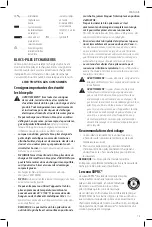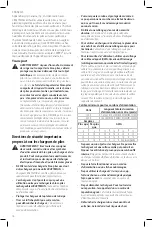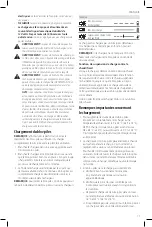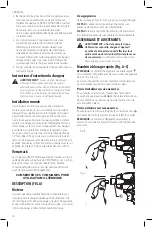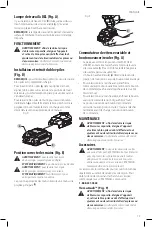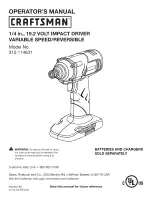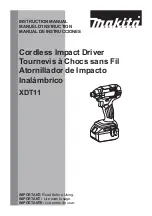
5
English
Important Safety Instructions for All
Battery Chargers
WARNING: Read all safety warnings,
instructions, and cautionary markings for the
battery pack, charger and product. Failure to
follow the warnings and instructions may result
in electric shock, fire and/or serious injury.
•
DO NOT attempt to charge the battery pack with
any chargers other than a CRAFTSMAN charger.
CRAFTSMAN
charger and battery pack are specifically
designed to work together.
•
These chargers are not intended for any uses other
than charging CRAFTSMAN rechargeable batteries.
Any other uses may result in risk of fire, electric shock
or electrocution.
•
Do not expose the charger to rain or snow.
•
Pull by the plug rather than the cord when
disconnecting the charger.
This will reduce the risk of
damage to the electric plug and cord.
•
Make sure that the cord is located so that it will not
be stepped on, tripped over or otherwise subjected
to damage or stress.
•
Do not use an extension cord unless it is absolutely
necessary.
Use of improper extension cord could result in
risk of fire, electric shock or electrocution.
•
When operating a charger outdoors, always provide
a dry location and use an extension cord suitable
for outdoor use.
Use of a cord suitable for outdoor use
reduces the risk of electric shock.
•
An extension cord must have adequate wire size
(AWG or American Wire Gauge) for safety.
The smaller
the gauge number of the wire, the greater the capacity
of the cable, that is, 16 gauge has more capacity than 18
gauge. An undersized cord will cause a drop in line voltage
resulting in loss of power and overheating. When using
more than one extension to make up the total length,
be sure each individual extension contains at least the
minimum wire size. The following table shows the correct
size to use depending on cord length and nameplate
ampere rating. If in doubt, use the next heavier gauge. The
lower the gauge number, the heavier the cord.
attention is needed, the battery electrolyte is composed of
a mixture of liquid organic carbonates and lithium salts.
•
Contents of opened battery cells may cause
respiratory irritation.
Provide fresh air. If symptoms
persist, seek medical attention.
WARNING:
Burn hazard. Battery liquid may be
flammable if exposed to spark or flame.
WARNING:
Fire hazard. Never attempt to open the
battery pack for any reason. If the battery pack case
is cracked or damaged, do not insert into the charger.
Do not crush, drop or damage the battery pack. Do
not use a battery pack or charger that has received a
sharp blow, been dropped, run over or damaged in
any way (e.g., pierced with a nail, hit with a hammer,
stepped on). Damaged battery packs should be
returned to the service center for recycling
Storage Recommendations
1. The best storage place is one that is cool and dry, away
from direct sunlight and excess heat or cold.
2. For long storage, it is recommended to store a fully
charged battery pack in a cool dry place out of the
charger for optimal results.
nOTE:
Battery packs should not be stored completely
depleted of charge. The battery pack will need to be
recharged before use.
The RBRC® Seal
The RBRC® (Rechargeable Battery Recycling
Corporation) Seal on the nickel cadmium,
nickel metal hydride or lithium-ion batteries
(or battery packs) indicates that the costs
to CRAFTSMAN. In some areas, it is illegal
to place spent nickel cadmium, nickel metal hydride or
lithium-ion batteries in the trash or municipal solid waste
stream and the Call 2 Recycle® program provides an
environmentally conscious alternative.
Call 2 Recycle, Inc., in cooperation with CRAFTSMAN
and other battery users, has established the program in
the United States and Canada to facilitate the collection
of spent nickel cadmium, nickel metal hydride or
lithium-ion batteries. Help protect our environment and
conserve natural resources by returning the spent nickel
cadmium, nickel metal hydride or lithium-ion batteries
to an authorized service center or to your local retailer for
recycling. You may also contact your local recycling center
for information on where to drop off the spent battery.
RBRC® is a registered trademark of Call 2 Recycle, Inc
.
.
Transportation
WARNING: Fire hazard. Do not store or carry the
battery pack so that metal objects can contact
exposed battery terminals.
For example, do
not place the battery pack in aprons, pockets, tool
boxes, product kit boxes, drawers, etc., with loose
nails, screws, keys, etc.
Transporting batteries
can possibly cause fires if the battery terminals
inadvertently come in contact with conductive
materials such as keys, coins, hand tools and the
like.
The US Department of Transportation Hazardous
Material Regulations (HMR) actually prohibit
transporting batteries in commerce or on airplanes in
carry-on baggage UNLESS they are properly protected
from short circuits. So when transporting individual
battery packs, make sure that the battery terminals
are protected and well insulated from materials that
could contact them and cause a short circuit.

















